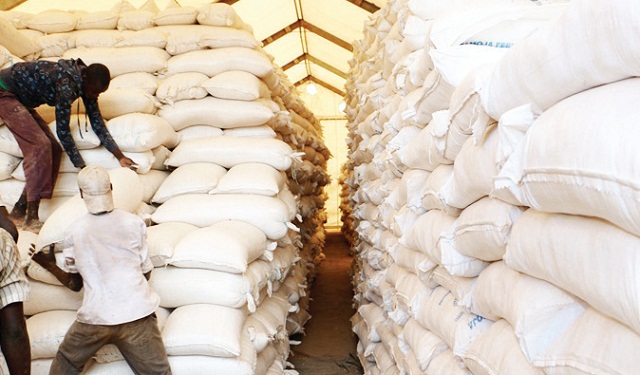
Aflatoxin contamination capital of the world
The other point is that, despite the picture being painted of Uganda being the source of aflatoxin contaminated maize in Kenya; the reality is that Kenya is the aflatoxin contamination capital of the world.
Kenya in 2020 lost most of the maize its Strategic Grain Reserves to aflatoxin and was pushed to import 4 million 90kg bags of maize at the peak of lockdown due COVID-19. At the time, a report by Famine Early Warning System Network said, the combined tragedies had left more than 1.8 million Kenyans on the brink of starvation.
In 2019 the Kenyan government had destroyed about 60 metric tonnes of maize because they were contaminated by aflatoxin. The maize was pronounced to be unfit for human and animal consumption and was sold to industries to be used as biofuel.
According to the experts, up to 70 percent of Kenyans are at risk of chronic exposure to the toxins., Consumption of maize contaminated with high levels of aflatoxins are said to have killed many people in lower Eastern Kenya who consumed highly contaminated maize during the 2004 and 2005 cropping seasons. Aflatoxin poisoning has also contributed increasing high levels of cancer disease in the country. They have also left many children stunted.
According to many reports, 2004 was Kenya’s worst year when an outbreak of aflatoxin poisoning from consumption of contaminated maize led to 125 deaths. That is recorded as one of the most severe cases of aflatoxin poisoning in world history. In November last year, the Kenya Bureau of Standards cited aflatoxin contamination when it banned the sale of some maize brands and peanut butter.
In fact, the short-lived Kenyan ban of Ugandan maize is not a one-sided trend. In 2019, Uganda was among countries that banned peanut butter produced in Kenya following a report in October by the Kenya Bureau of Standards (KEBS) that they were aflatoxin contaminated.
That is possibly another reason why, while lifting the ill-advised maize ban on March 11, Kenya’s Agriculture Cabinet Secretary Peter Munya, threw in some tough conditions.
He said dealers in maize imports would be required to be registered, the consignments entering their market would be accompanied with a certificate of conformity on aflatoxin levels and that traders will have to issue details of their warehouses.
It said, the certificate of conformity should indicate that the aflatoxin levels comply with the maximum required levels of 10 parts per billion. That Kenyan traders importing maize from Uganda to Kenya would be required to also have a certificate of origin from the counties of produce before they get clearance at the border points.
But many questions remain unanswered about why Kenya appears to be looking for pretexts to ban imports from Uganda. Does the EAC common market Protocol, which allows free movement of goods and services, still matter? Why is there a breakdown in communication among EAC leaders? What should the leaders do to stop such acts in the future? And most critically, should Uganda trust Kenya’s claim that it has lifted the ban on maize imports?
Uganda’s growing economic power
Pundits on EAC matters are divided on these issues; some say there are political differences between partner states, while others insist, Kenya’s moves are purely an economic battle.
“The problems at hand call for leadership which probably East Africans do not have,” says Fred Mukasa Mbidde, the outgoing Uganda Member of Parliament at the 3rd East African Legislative Assembly, “The leadership that we need now is an establishment of a one stop testing centre for each border if we cannot trust the testing capacity of individual countries.”
Mbidde says the closure and limitation of imports particularly of maize that allegedly contain aflatoxins can only attract tests and standardisation.
“It has nothing to do with bilateral relations,” Mbidde told The Independent.
He said, member states need to implement the EAC Standardisation, Quality Assurance, Metrology and Testing Act, 2006 and put in place an authority to oversee matters standards.
“Maize allegedly containing aflatoxins is bad not only for Kenyans but also for Ugandans…in fact such maize should be quarantined,” he said.
David Livingstone Ebiru, the acting executive director for Uganda National Bureau of Standards (UNBS) told The Independent that, as an agency, they have harmonised EAC standards that cover the quality requirements for cereals and grains and, have certified 23 companies to export cereals outside Uganda.
“We are not sure whether the rejected maize had come from Uganda and which laboratory had handled the testing,” he said.
Isaac Shinyekwa, the head of trade and regional integration department at the Makerere based Economic Policy Research Centre, said Kenya has a right to stop importation of dangerous products in line with standards put in place by the EAC protocols, but he said, it mishandled it in the first place.
He said the commodities being contested are sensitive products of EAC because partner states charge a common external tariff beyond 25% with the aim to develop capacity within the EAC to become self-sustaining.
Shinyekwa said in such cases, partner states could opt for what is termed as ‘voluntary export restraint scheme’ where an importing country asks the exporting partner state to limit quantities of a particular product for fair reasons. He said there should be a tribunal of sorts to handle complaints from partner states.
“It was unfair for them to just wake up and put a ban without consulting sister countries,” he told The Independent.
Kenya is not alone in this. Rwanda has since August 2019 sealed its borders with Uganda.
But in Rwanda’s case, according to Shinyekwa, “there is more that the public does not know and the issue between the two countries (Uganda and Rwanda) resonates more from the security perspective than trade”.
Daniel Birungi, the executive director of Uganda Manufacturers Association says, Kenya has always benefited from both access to cheap Ugandan raw materials and fresh produce for their agro – processing industry and market for finished products.
Birungi says Kenya has since 2017 intensified imposition of non-tariff barriers with fears of possible takeover of the balance of trade power.
In that year, for the first time in decades, Uganda recorded a trade surplus with Kenya.
Uganda has developed capacity to manufacture and process goods that were originally being imported from Kenya from her own raw materials as well as imported inputs to survive and promote her economic independence.
This has been facilitated by the progressive initiatives such as the Buy Uganda Build Uganda Policy and the Reservations and Preference Schemes under the Public Procurement and Disposal of Public Assets Authority.
As a result, there has been an increase in industries and growth of production efficiencies to feed both domestic consumption and export markets.
Experts say Uganda’s growing economic power within the EAC could be causing fear on the side of Kenya, EAC’s largest economy.
But Kenyan exports into Uganda have also increased from US$1.1billion in 2017 to $1.2 billion in 2018 and 2019, according Bank of Uganda and Uganda Export Promotion Board figures.
In 2018/2019 Uganda imports from Kenya amounted to US$711 million and exports were US$433 million. In 2019/2020 Uganda imports from Kenya amounted to US$730 million and exports were US$423million.
Based on this, Birungi says Kenya’s decision to block entry of Ugandan-made goods defeats the whole purpose of the EAC.
He said, some of his members report to him that even goods that are certified by UNBS are blocked from entering Kenya.
Statistics from the EAC secretariat indicate that the region has about US$5 billion worth of intra-regional trade and Kenya controls a chunk of about US$1.35 billion of that. It is the biggest exporter.
Shinyekwa said, because of this, it is in Kenya’s interest to practice and promote fair trade. He said, Kenya’s recent actions show that it possibly fears losing its competitive trade advantage.
Although Rwanda is a small market, its blockade on Uganda and Burundi appears to be hurting the economies of all three economies.
The Rwanda economy was in February reported to have fallen into its first recession. According to the World Bank, GDP growth is estimated to have dropped by 0.2% in 2020 compared to a projected expansion of 8% before COVID-19 outbreak. Kenya’s economy only grew by 0.6% in the first half of 2020. Uganda, meanwhile, is projected to record the lowest GDP growth of about 3.7% in 2021.
 The Independent Uganda: You get the Truth we Pay the Price
The Independent Uganda: You get the Truth we Pay the Price


